June 9 Greece to Italy (Day 256)
We had a relaxed morning, getting ready to leave Corinth by cab, train and bus to Patras to catch an overnight ferry that will take us through the Ionian Sea and up the Adriatic Sea to the boot heel of Italy! The ferry was not due to leave until 5:30pm so we had plenty of time…or so we thought! We got to the train station by cab to catch the train to Kiato where due to ongoing (years of ongoing) maintenance it is required to take a bus the one and a half hours to Patras. Unfortunately it is required to get a seat reservation on that bus! We had tried by several methods online to get said bus seat reservations, to no avail, and thought we could get them at the train station the morning of our travel. They were sold out! The next bus would not get us to Patras in time to catch our ferry! But, the ticket agent suggested we take a cab to the bus station in town and take a bus direct to Patras. So we quickly got a cab and zoomed to the bus station, got our bus tickets, found some fast food for lunch and quickly settled into our bus seats on the crowded bus!

The highway follows the north coast of the Peloponnese and as we approached Patras the Gulf of Corinth narrows and we could see the mainland across the water.
We reached the bus station in Patras and went into the ferry office nearby to get our paper tickets for the ferry and discovered that the ferry terminal is 4 km away! Too far to walk, and the hassle of getting city bus service, plus the fact that it was about 95 degrees out already, eased our decision to catch a cab! We actually got to the ferry port with 2 hours to spare! We relaxed, went through the duty free store, got some beers and found a place to sit in the cool air conditioned waiting room!
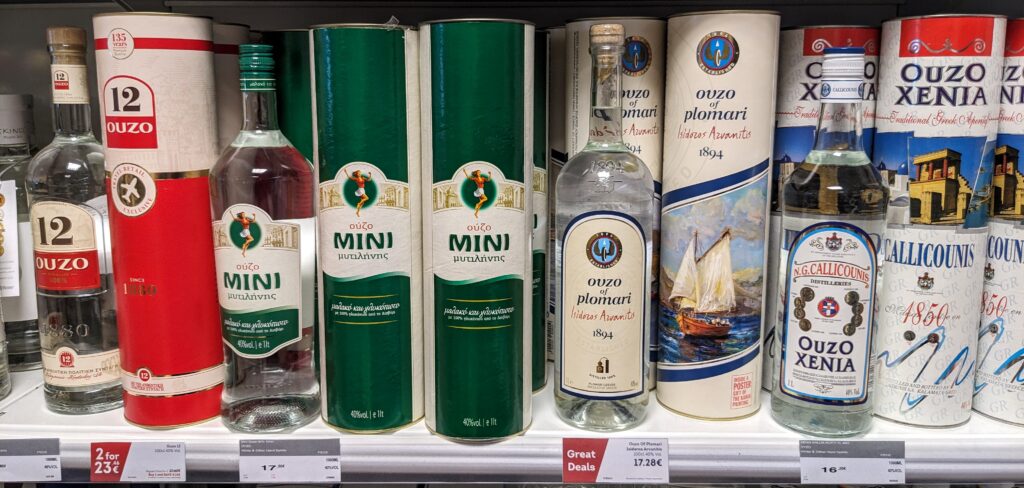
So many duty-free choices! We decided to get wine instead, probably for the best!
The announcement was made to board our ferry and go through the security check, scanning our passports and baggage, and a line formed outside in the hot sun. We chose to wait until the line dwindled down and we still had about 45 minutes to spare, to avoid the sun! We were almost the last in line and as we ran our baggage through the woman checking our tickets said “WAIT, you have to go check-in at the ticket office”. Apparently we did not get “TICKETS” at the previous ferry office by the bus station! So we had to go back in the building and stand in a short line to get our “tickets”, and also the key cards to our sleeper cabin. The ticket agent casually said “no problem, your ferry has been delayed for 2 hours, at 7pm you can go back through security”. Well, we had time for another beer, but the delay would affect our trains in Italy scheduled for tomorrow when we dock. Robert went back to the ticket window, this time in a much longer line, to ask when the ferry would dock so we could rearrange our trains then. He finally got to the window and the agent said “you will get into Ancona 2 hours later than scheduled”. Robert said “we’re not going to Ancona, we’re going to Bari”. The agent said, “GO, QUICK, NOW! Your ferry is leaving”! We RAN to the security line and they rushed us through, we were literally the very last people getting on the ferry! It’s a good thing Robert stood in line or we would have watched the ferry leave the dock! Don’t believe everything “people who should know” tell you!

As we left Patras we looked back and saw this beautiful bridge.
The Rio-Antirio Bridge, officially the Charilaos Trikoupis Bridge is a marvel of engineering. It links the towns of Rio on the Peloponnese side to Antirio on mainland Greece.

Further out in the Ionian Sea we passed this lighthouse.
Named Doukáto or Lefkatas Lighthouse, looking much better in a video in the link, located on the island of Lefkada, is about the last piece of Greece you see as you head out to the open sea!
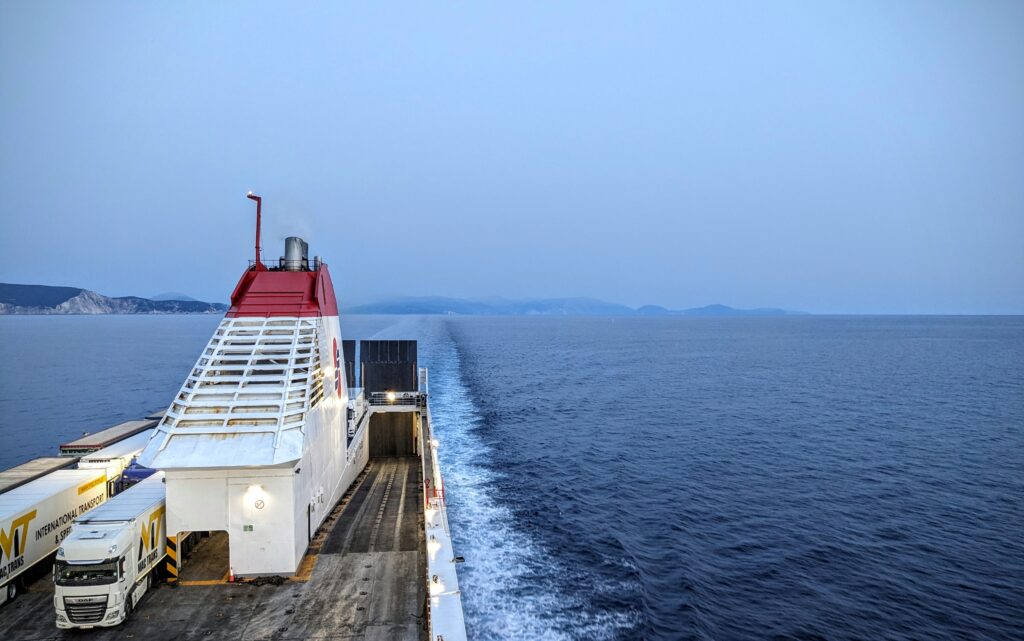
As the sky darkened we headed for dinner before going to our cabin for a good nights sleep!
June 8 Acrocorinth (Day 255)
You may have noticed the big mountain in the background of many of the pictures of Ancient Corinth, that is Acrocorinth, translated as “Upper” or “High” Corinth. It is an amazing archaeological site that layers the many civilizations that have been in control over the centuries from about the 4th century B.C. to the 19th century. Today we took a cab up the hill to explore the free site!

The whole top of the hill is circled by ancient walls, fortifications to protect the city inside the walls, as well as the city at the base of the hill.
There are 3 successive walls protecting the interior, each with a protected gate.
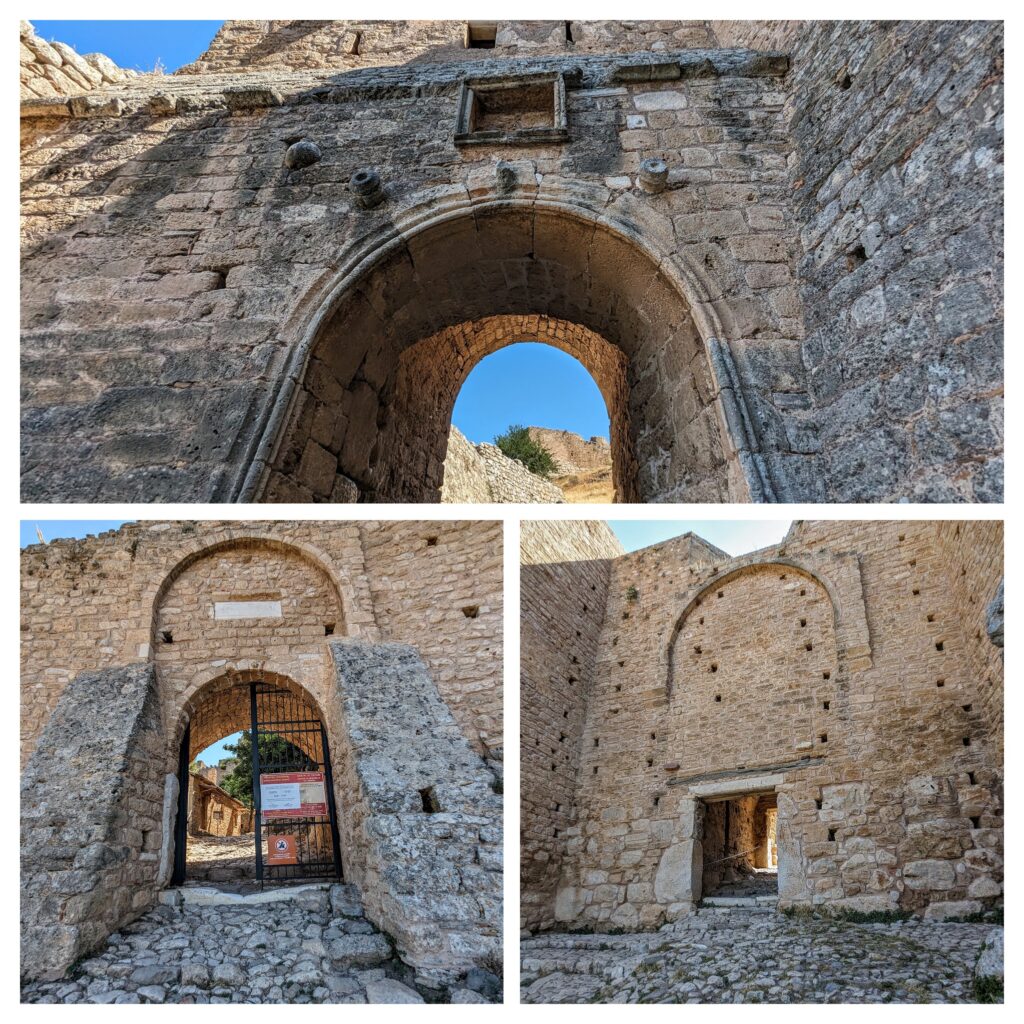
The 3 gates. The first (lower left) has an iron gate on it now, the second (top) has an impressive archway, and the third has a smaller doorway in a massive wall with a tower on each side!
We hiked up the steep cobbled road, worn smooth and somewhat slippery by the eons of traffic and weather, through the gates, to the interior where we wandered around, occasionally stopping in the sparse shade to cool down. The view is fantastic, although it is hazy out.
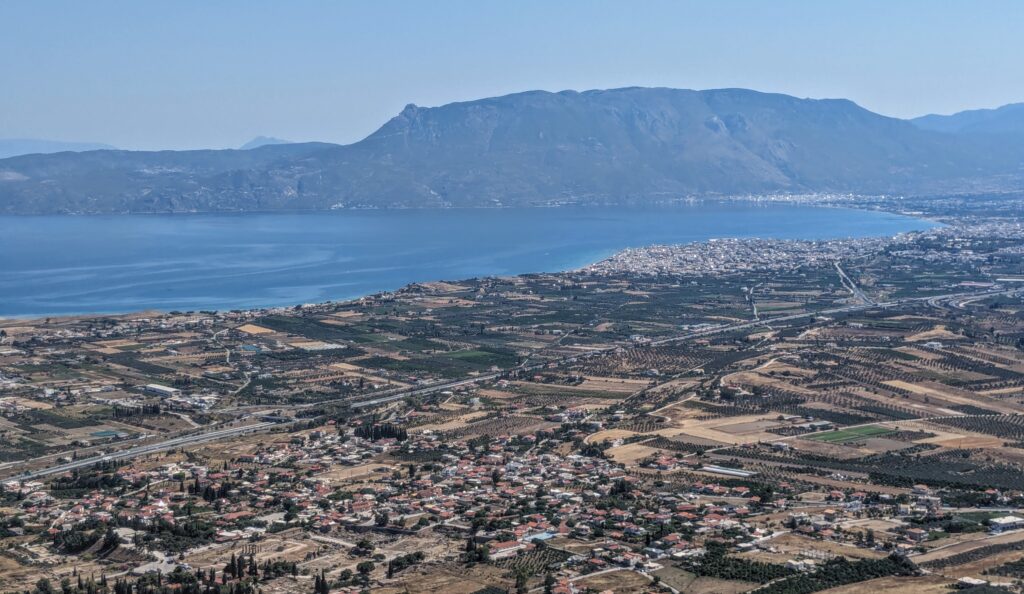
Looking down on Archaia Korinthos. If you look very closely you can see the pillars of the Apollo Temple in the lower left!
The hill has a commanding view of the isthmus connecting mainland Greece with the Peloponnese peninsula. The isthmus divides the 2 waterways, the Saronic Gulf on the Aegean Sea side and the Gulf of Corinth on the Ionian Sea side, the body of water in the above picture. Controlling the trade routes across the isthmus and the two waterways was very lucrative for Corinth throughout the ages! In ancient times a road was built across the isthmus in order to drag ships across the land barrier. In 1893 a canal was dug (carved? out of the rock) across the isthmus and is still used today.
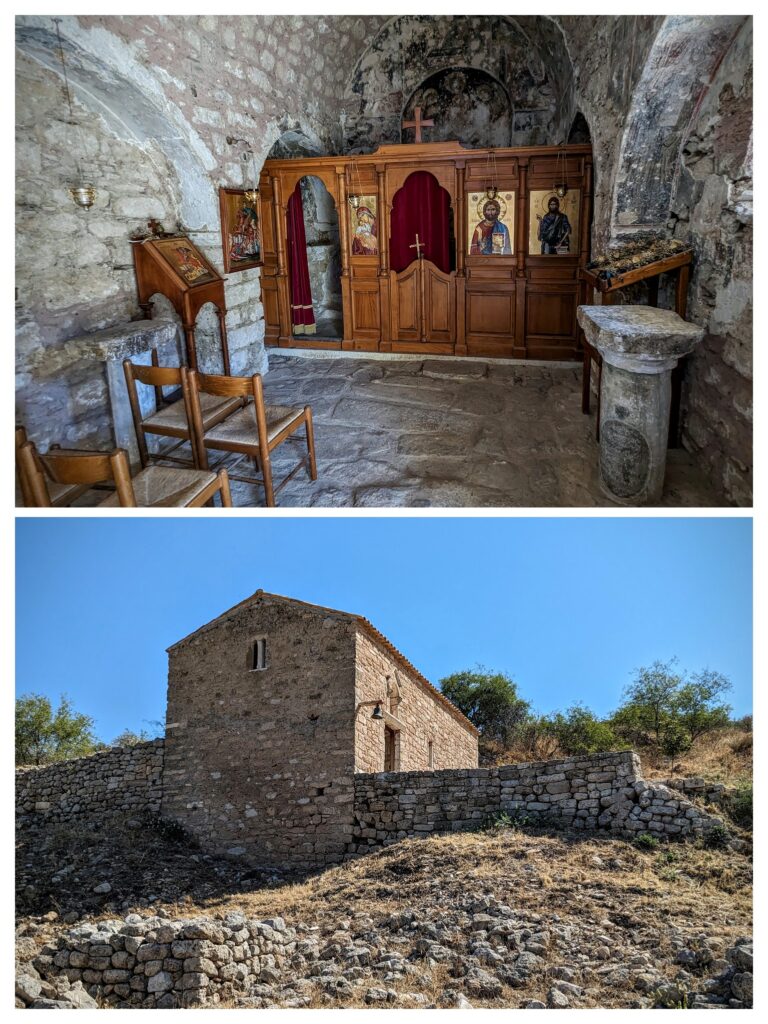
The only intact building on the site is this small church which is still used.

The engineering and tremendous workload to build the walls and the many buildings that had been inside the walls, is staggering!
On the west side of the hilltop is a still functioning spring, the Upper Peirene spring. “With its secure water supply, Acrocorinth’s fortress was used as the last defending line in southern Greece repelling foes from entering the Peloponnesian peninsula.” There is a lower Peirene Spring in the ruins of Ancient Corinth which has a great story!
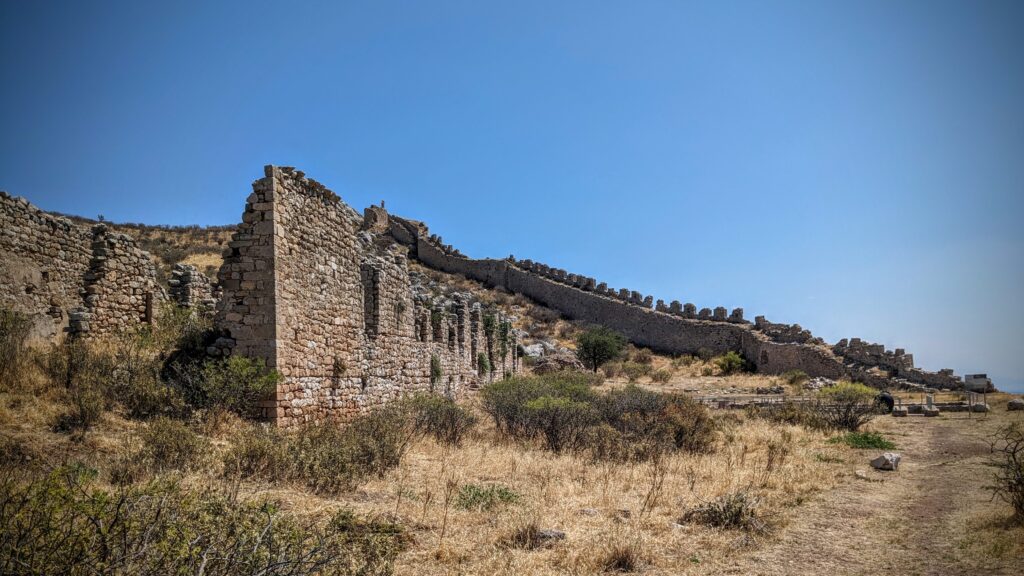
Approaching the spring, it is down a flight of narrow stairs on the left in this picture.

I continued down the steps to the water and dipped my hat in to wet it and act as a swamp cooler on my head out in the hot sun!
After several hours exploring we headed back to the parking lot hoping to find a cab to take us back down. We had not made arrangements to be picked up and discovered there were no cabs waiting! We had to start walking the 2.3 miles down! At least there was a breeze, hot but not humid! Luckily we were picked up by a kind Canadian who was visiting his daughter who is an Archaeologist in the area! We got back, cleaned up and waited until evening to go out again! Dinner of pizza then a walk around the small town center and a view of the Temple of Apollo lit up for the night.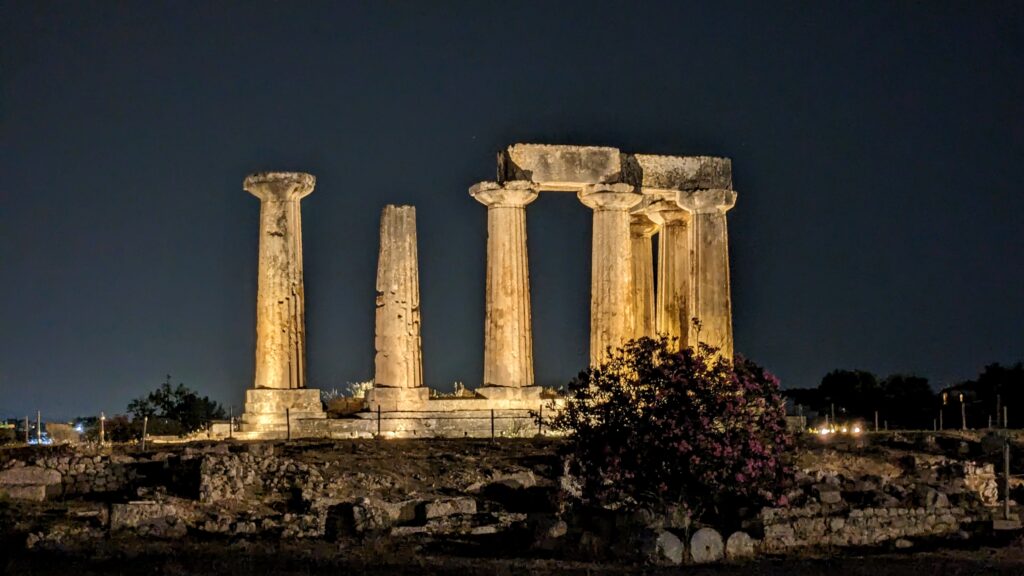
We started towards our room and stopped at a bar with live music. While listening to the authentic Greek music we were offered beers by a local couple! We ended up staying for an hour, listening to the music, watching the dancing and drinking and singing and having a great time!
June 7 Archaia Korinthos (Day 254)
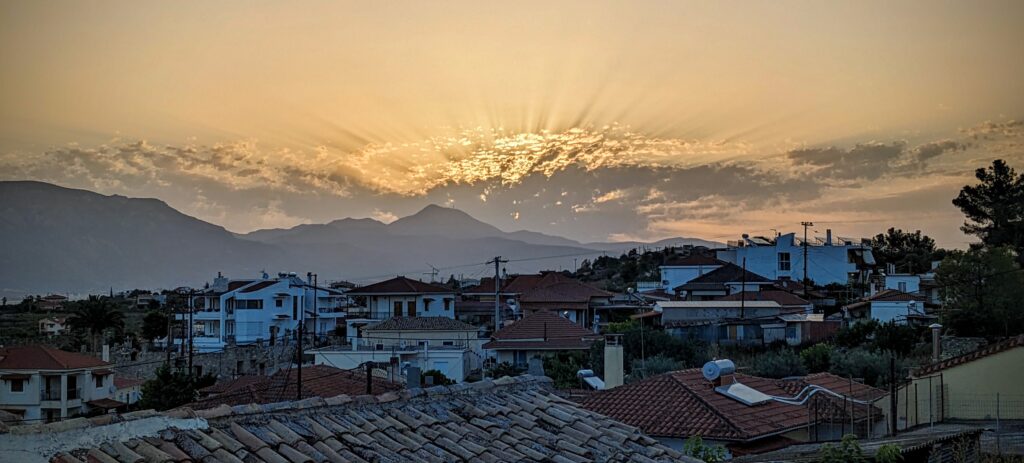
A beautiful sunrise over the mountains!
Today we will cross the street and visit the Archaeological Museum of Ancient Corinth, an open air museum we can see from our Airbnb! We got there after breakfast and meandered around until we went into the Museum which we did not know was there. In a courtyard a young woman Archaeologist was manning a display of the work being done at the site, work that has been ongoing for 140+ years by the American School of Classical Studies at Athens! She was a font of interesting information and piqued our curiosity!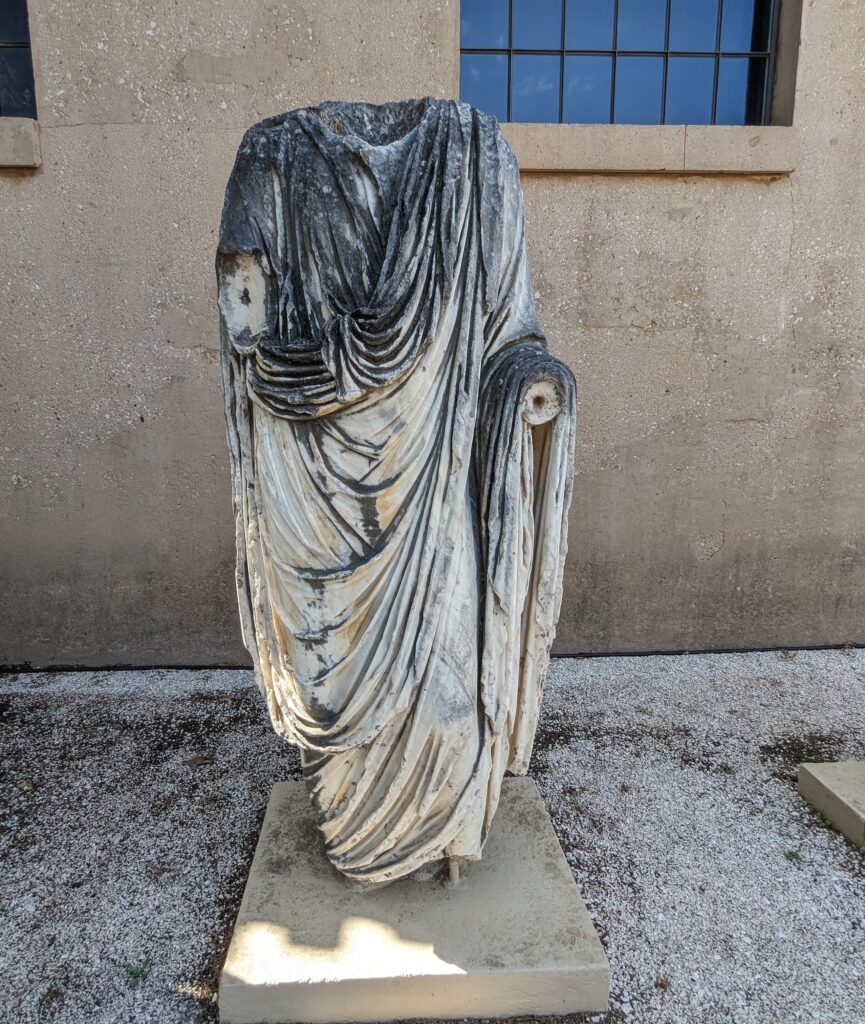 First off she explained the propensity of headless, armless statues! Wear and tear of course, the neck and arms being weak points in sculpture, easily fractured, and the fact that they made the statues en masse, to be interchangeable! The heads were sculpted separately to match the subject, and the arms could be holding different objects; law books, scrolls, wreathes, etc.!
First off she explained the propensity of headless, armless statues! Wear and tear of course, the neck and arms being weak points in sculpture, easily fractured, and the fact that they made the statues en masse, to be interchangeable! The heads were sculpted separately to match the subject, and the arms could be holding different objects; law books, scrolls, wreathes, etc.!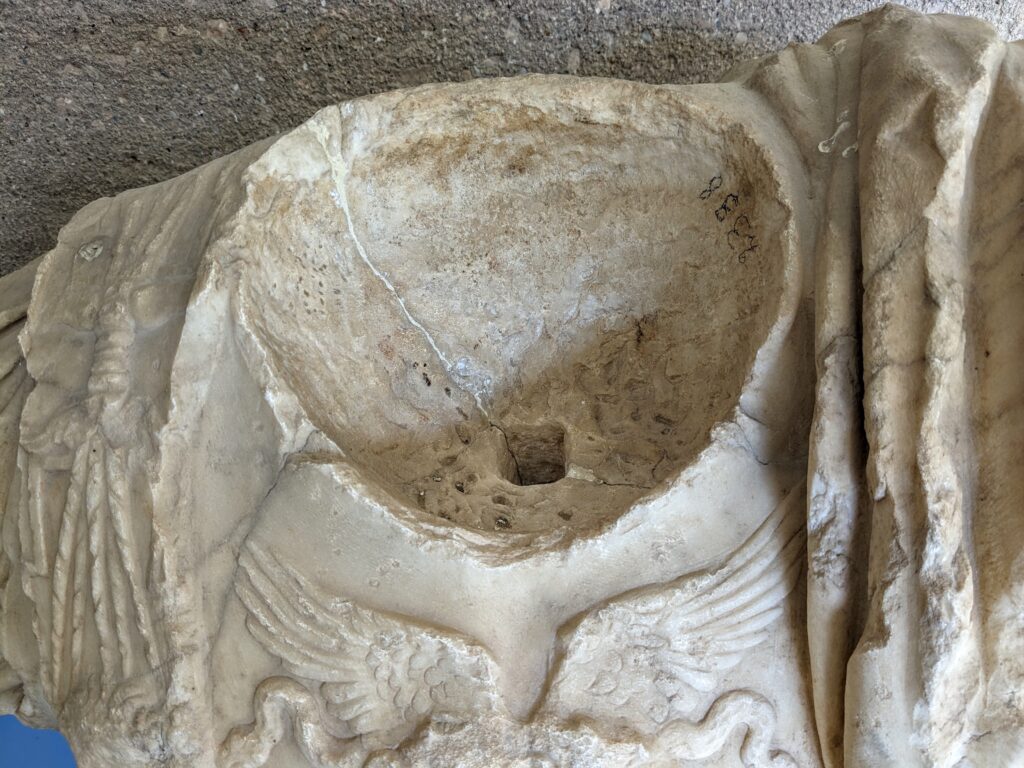 Another statue showing the insert for the appropriate head!
Another statue showing the insert for the appropriate head!
She went on describing the archaeological work being done by academics from various institutions that sometimes bring to light the everyday lives of the inhabitants of Ancient Corinth! For examples;
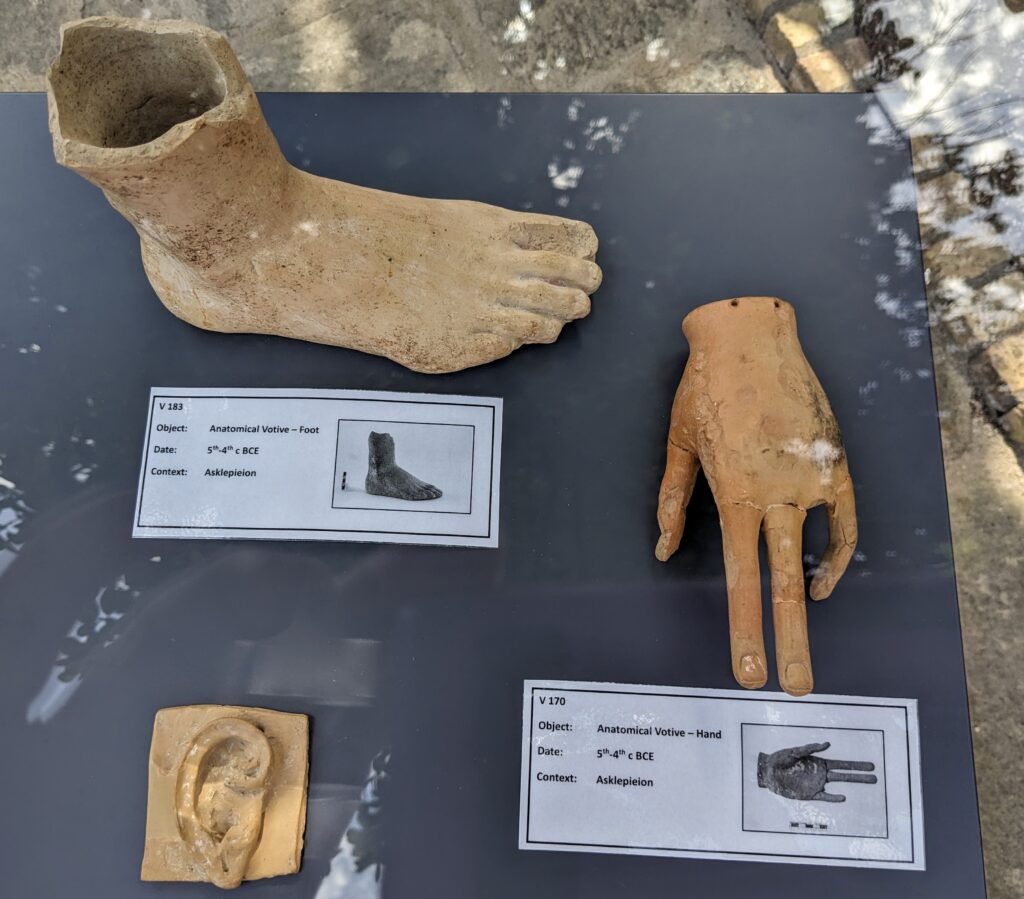
The many figurines and sometimes life size statuary of body parts found in the temples dedicated to the Gods of healing (sort of like ancient hospitals) that were used to invoke the Gods to heal said body part, or to thank the Gods for successful healing. The Priests or Acolytes of the temple gave prescriptions or prayers and sometimes even performed surgery to assist the Gods in the healing process!
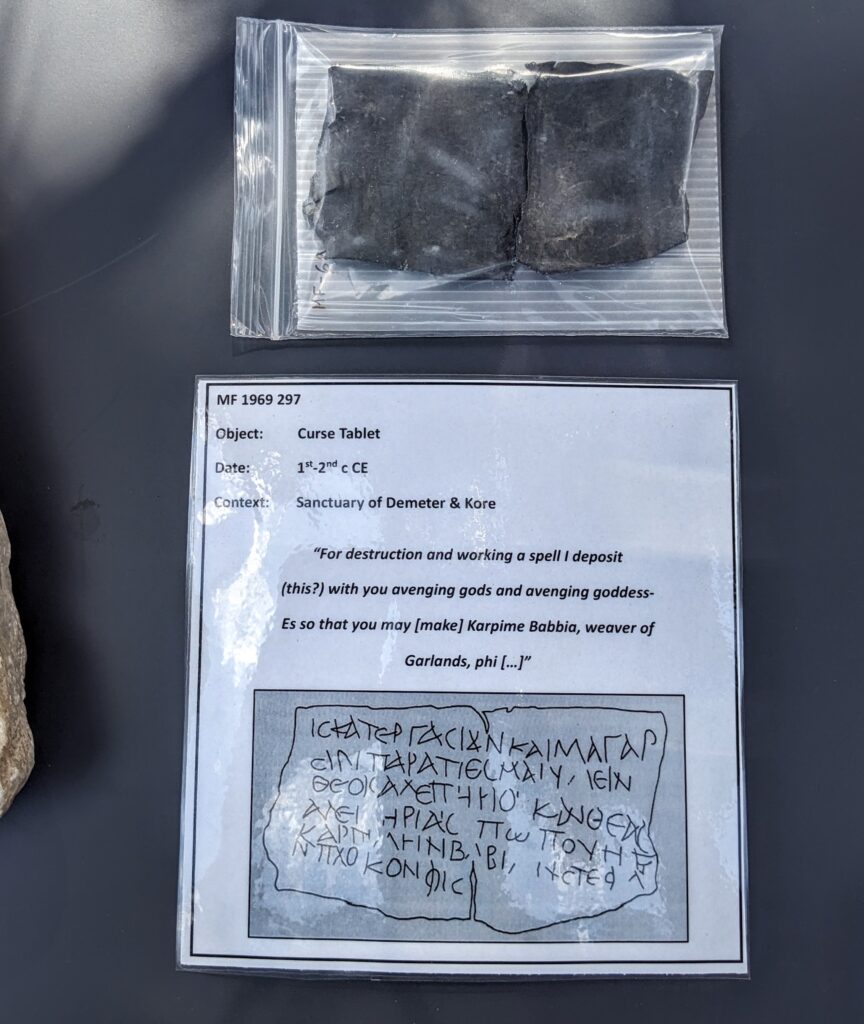
The lead tablets that were inscribed with curses, found in the vaults of some temples. There was a brisk business for inscribing the thin lead plates with specific curses against specific persons and the punishments the wronged wanted inflicted on the cursee! There were several plates targeting one particular seller of garlands from different people! What did that person do to warrant so many curses against them?
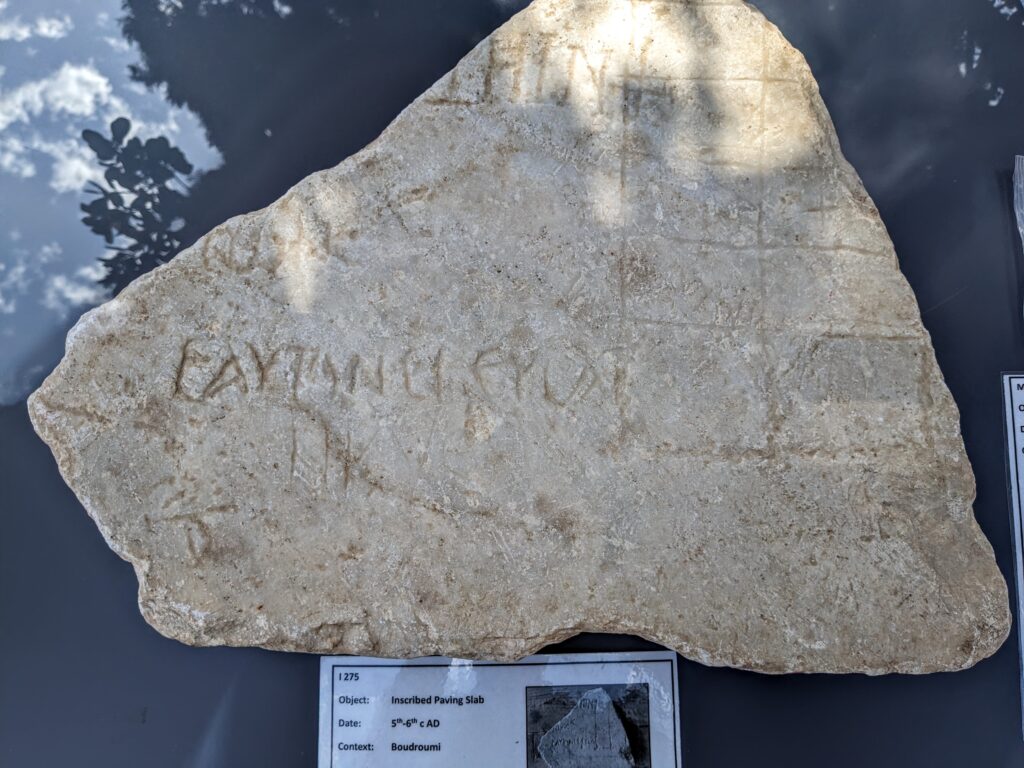
The floor flagstone found in what was first thought to be a workshop, but determined, by the inscriptions carved into the stone, to be a jail cell! The carving revealed that the jailed felt wrongly accused and convicted (that never changes!) and the boredom of jail, with a boardgame carved into the floorstone of the cell! The cell had probably been a dirt floored workshop or retail shop but was repurposed in a later era as a jail cell that for obvious reasons would need a solid floor, hence the floorstone!
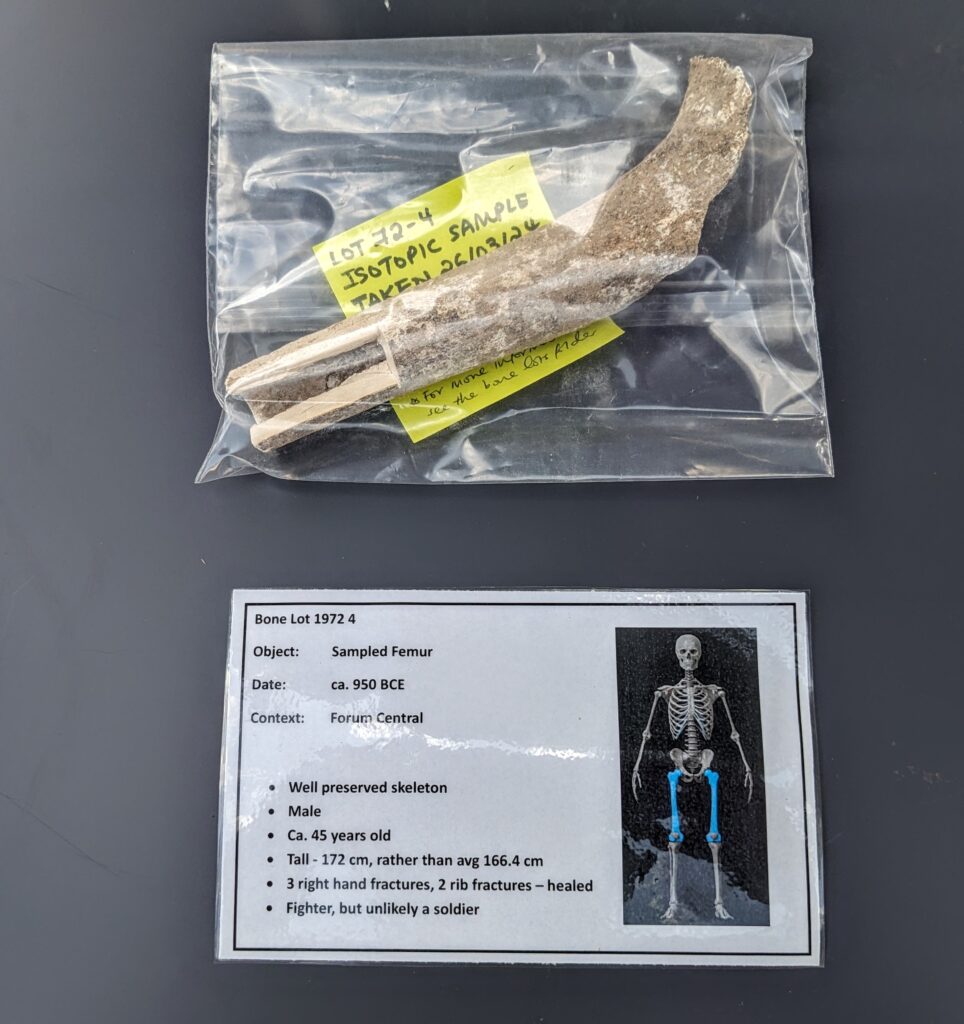
The skeletal remains found in cemeteries, through forensic analysis, have brought to light many aspects of the lifestyles of the inhabitants through the centuries. The fact that these remains bore evidence of healed fractures of the hand and ribs indicate he may have been a fighter, but not a soldier. A soldier would have injuries of the face and head that would likely have killed him!
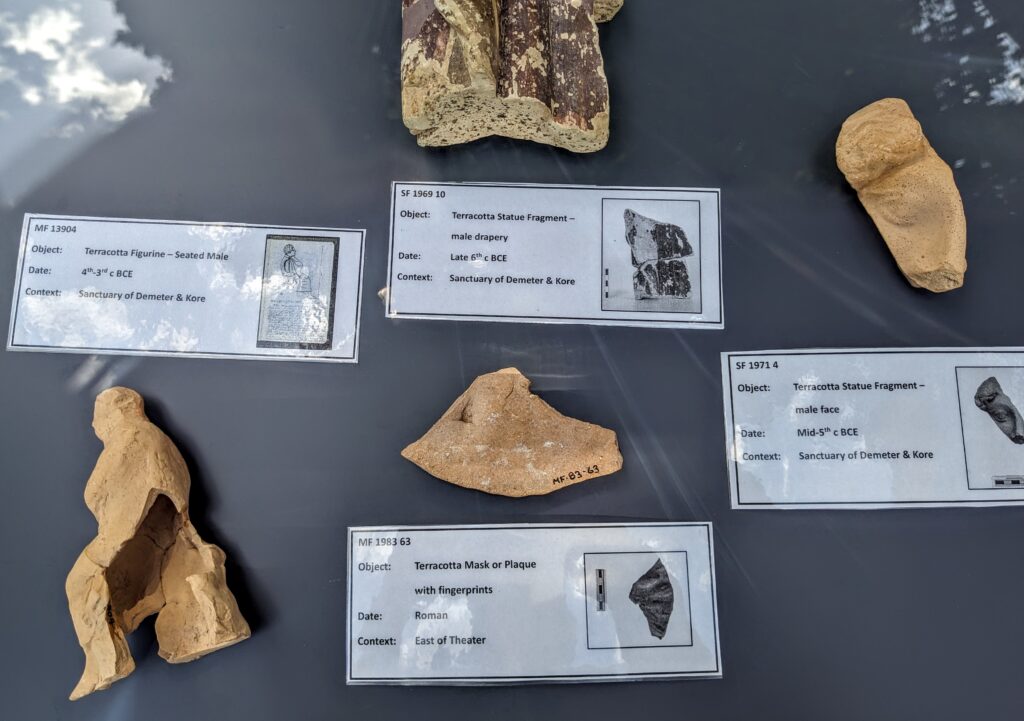
The mass production of clay figurines for temple worship, funerary gifts, household altars, and even toys was thought to be manufactured mostly by men. Study of the fingerprints embedded in the clay by researchers collaborating with the FBI has revealed that women and even children were active in the business!
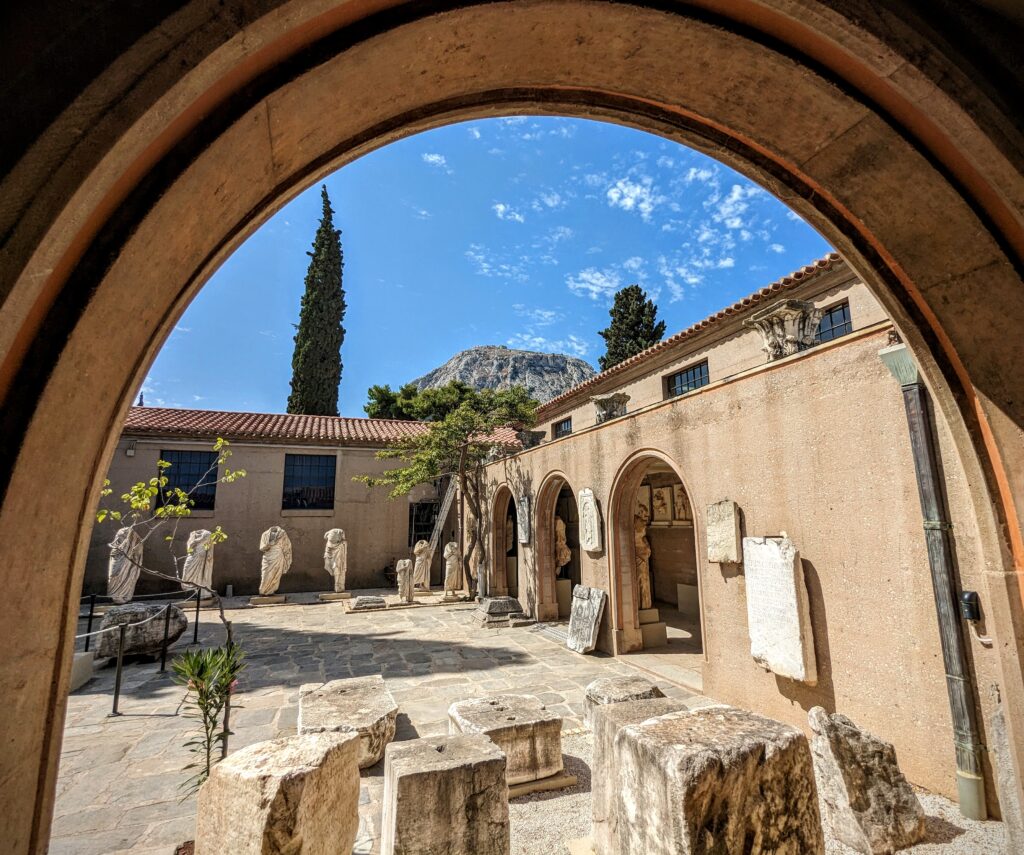
The halls surrounding the courtyard contain many artifacts discovered in the ruins of the ancient city. Spanning time from the Neolithic Period 6,500 B.C. to the present! Greek, Roman, Byzantine, Frankish, Venetian, Ottoman, Modern, all layered on top of each other!
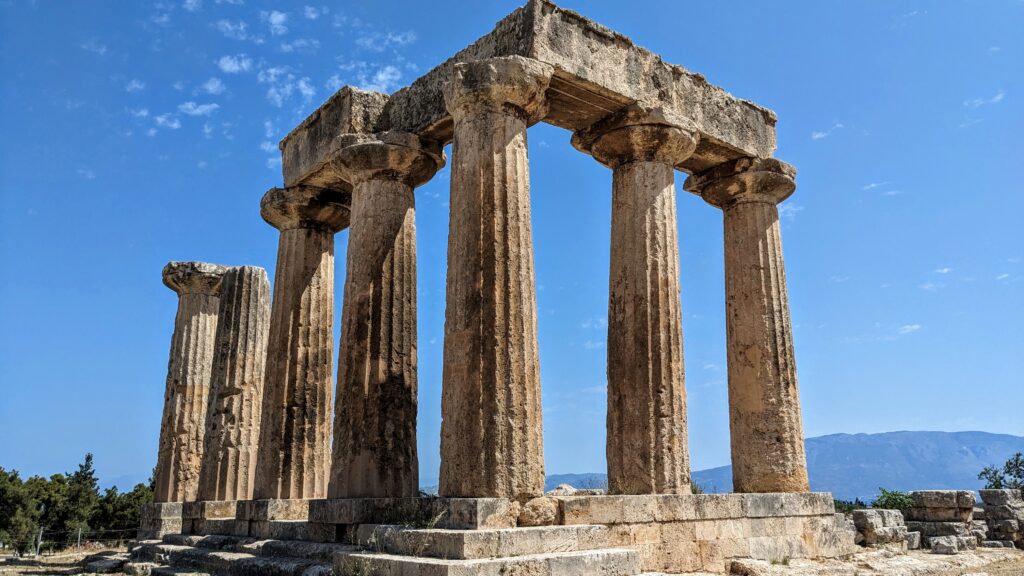
Outside, the many acres that have been excavated reveal temples, marketplaces, amphitheaters, baths, paved roads and pavilions, too much to take in! Dominating it all are the columns of the Temple of Apollo! Greek or Roman? The history is so long and complex it boggles me!
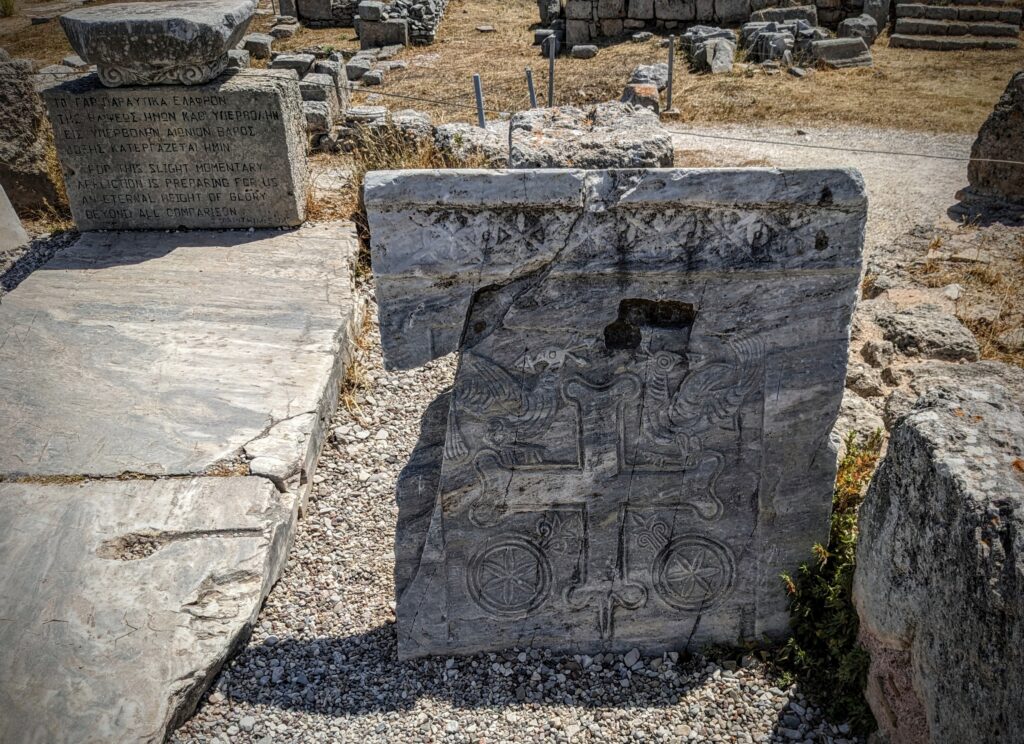
Throw in the Christian aspect and another layer is slathered on! This is the site where the Apostle Paul was put on trial and acquitted of “conducting illegal teachings”.
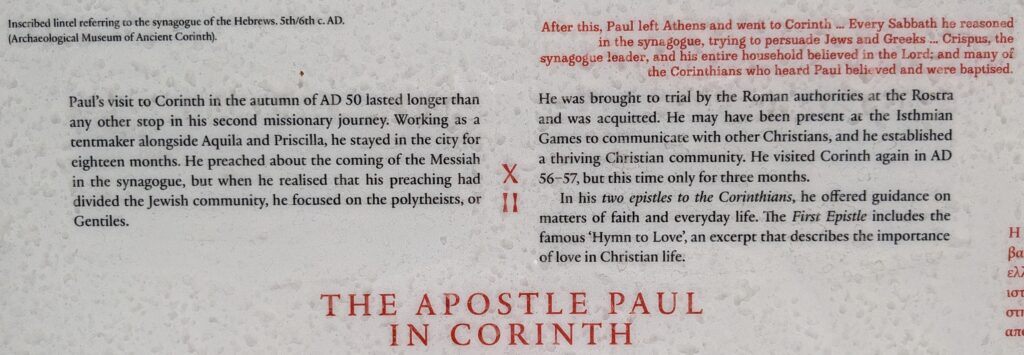
“And the rest is history”!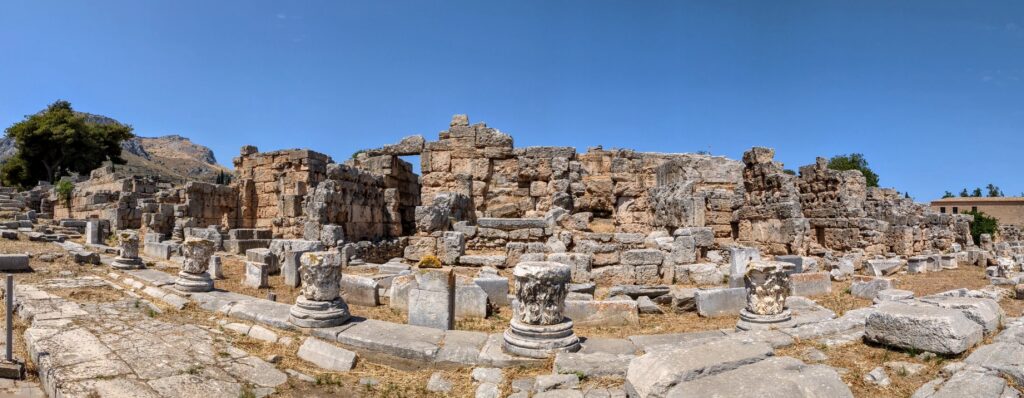
June 6 Ferry to the Mainland (Day 253)
We’re moving on from the islands to the mainland today. Our Seajet fast catamaran ferry will take us directly from Syros to Piraeus, the major port to Athens. We had a few hours in the morning before we boarded so we wandered around town a little bit.
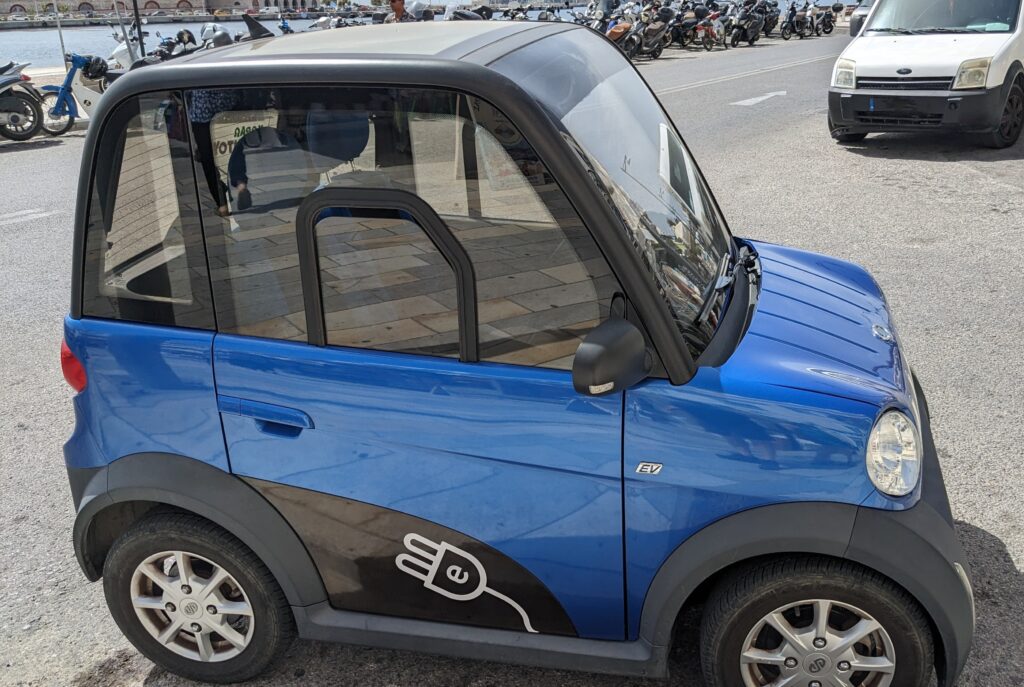
The cutest little electric car! Great for an island mode of transport!
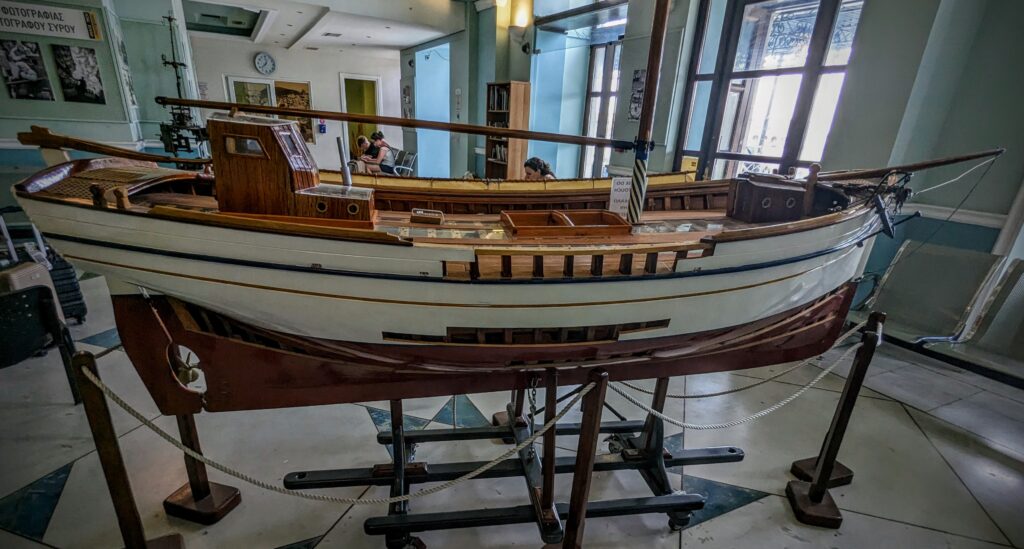
In the port waiting room this scale model shows the most common mode of inter-island transport of the 19th & early 20th century!

Our ferry was about 20 minutes late, and we took off, trying to make up time! We headed into cloudy weather with a little sprinkle of rain. Unfortunately it didn’t break the hot spell!
When we arrived at Piraeus, a suburb of Athens, we hiked the 15 minutes to the train station. When we got there we were told it’s the wrong station! Those trains only went to Athens, we’re heading west to Korinthos (Corinth). Luckily that station is only a block away!
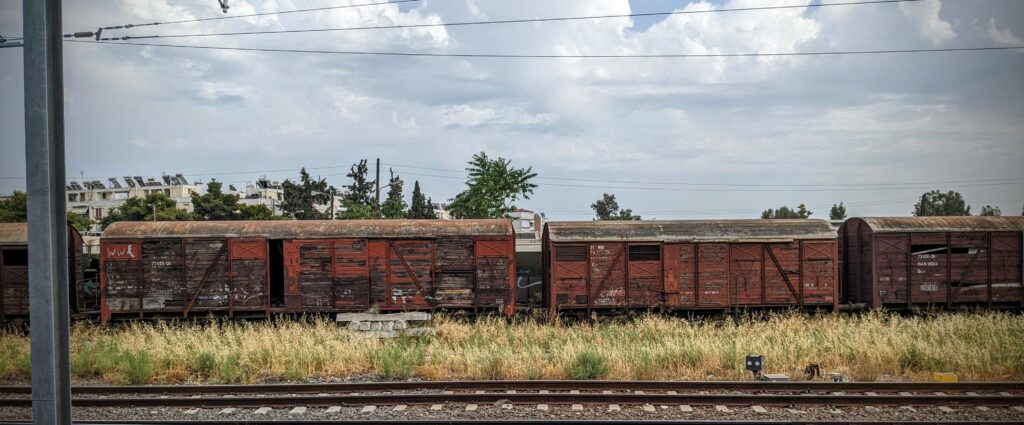
We got the feeling we’re heading into the hinterlands! Not the metropolis of the Acropolis! Which is fine with us!
We arrived at the Korinthos station and had a taxi waiting for us to take us to Archaia Korinthos (“Ancient” Korinthos). Corinth in English, Korinthos (Κόρινθος) in Greek!
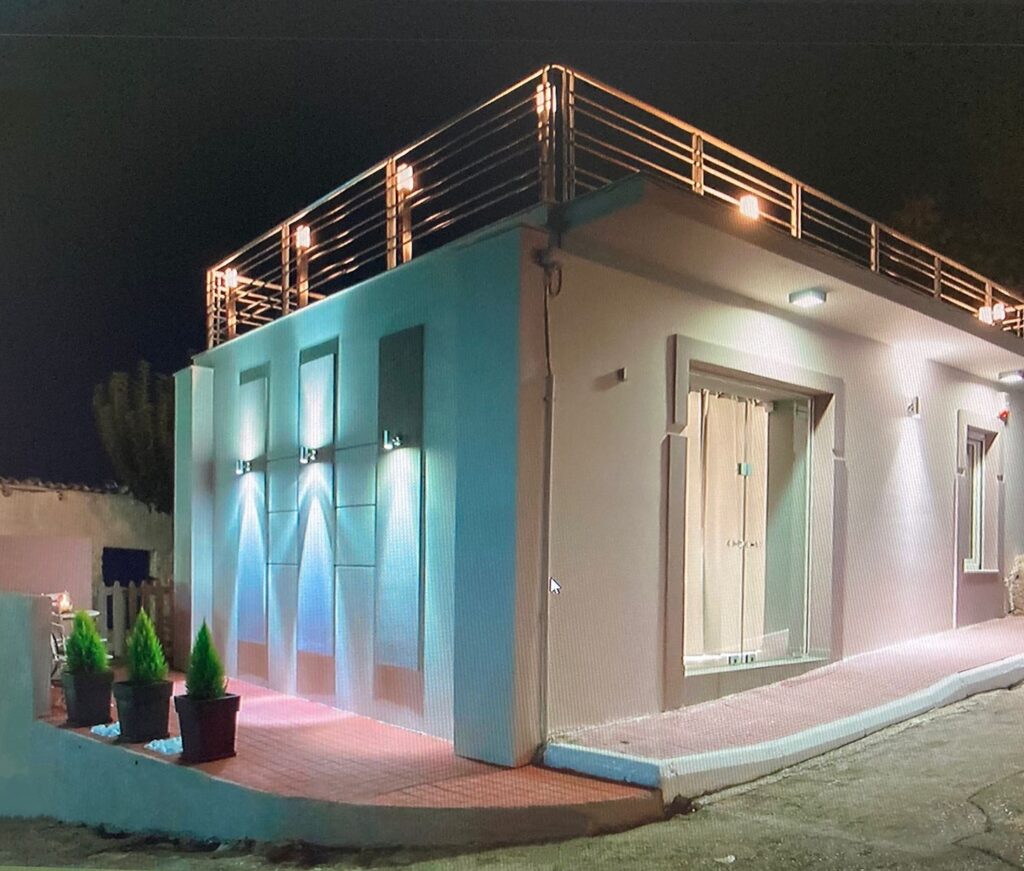
An older Airbnb picture of our accomodation, We arrived before dark and were greeted by our host’s father who gave us a tour and we settled in.
We of course went up to the rooftop terrace and got some pictures!
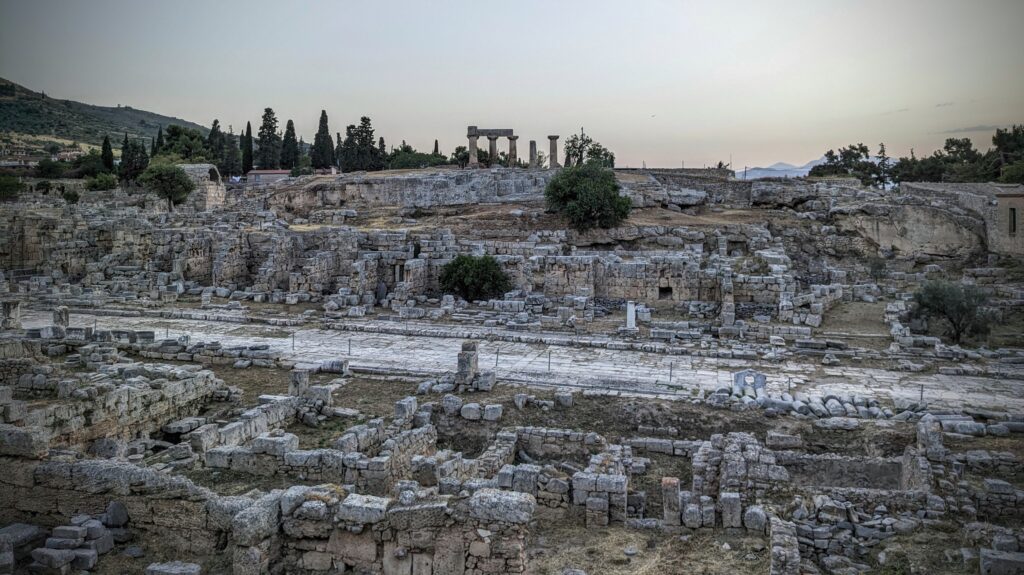
The archaeological site of the ancient city is steps away!
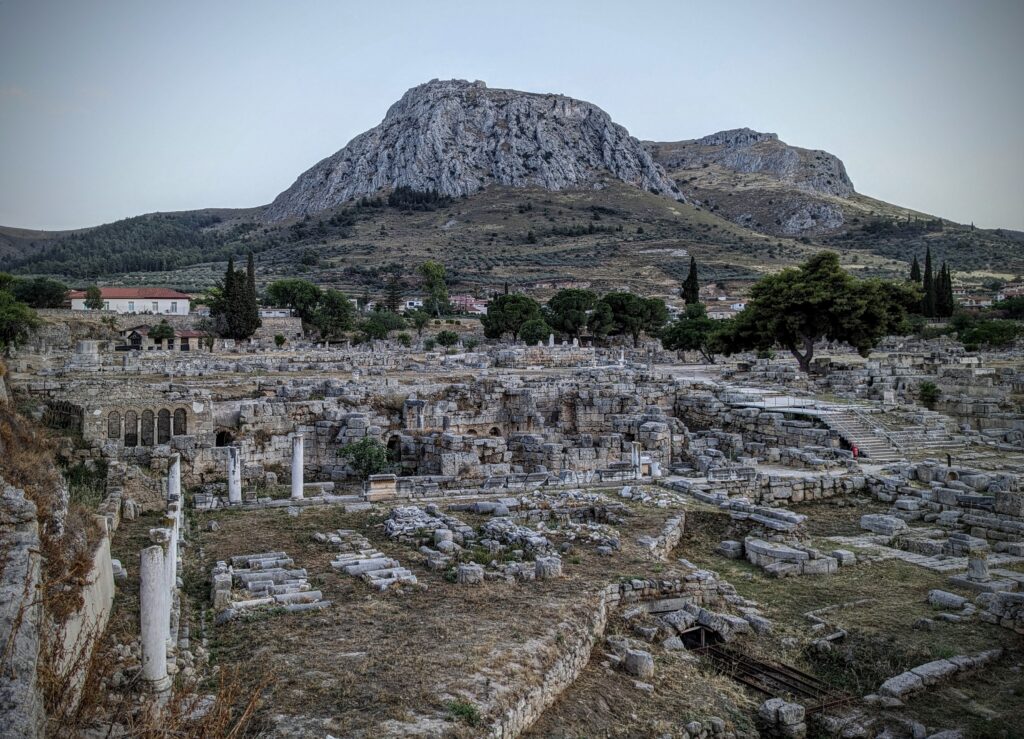
Overlooking the village is Acro Corinth (“High” Corinth) on the top of the distant hills.
We walked through the tiny village and found a pizza parlor and had dinner.

We had a fantastic salad first, then the pizza!
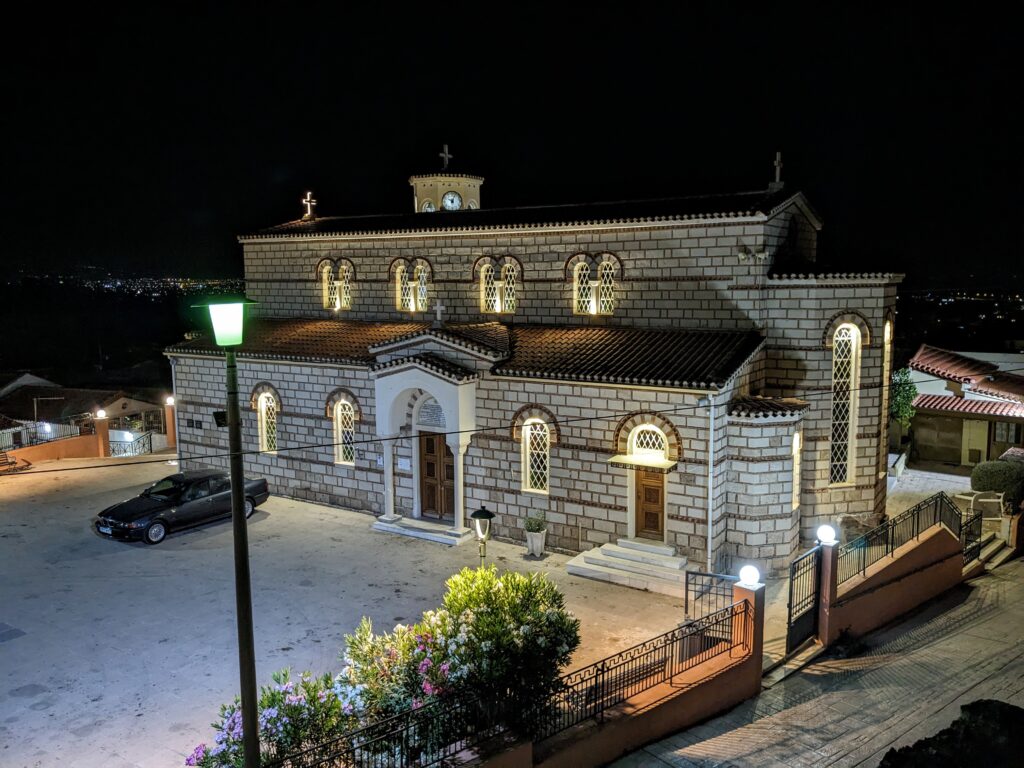
We had nightcaps of wine on the rooftop terrace, looking down on the Greek Orthodox Church just across the street!
June 5 Last Night (Day 252)
We spent the day relaxing and keeping cool, organizing and packing for our next move. In the cool of the evening we headed out.
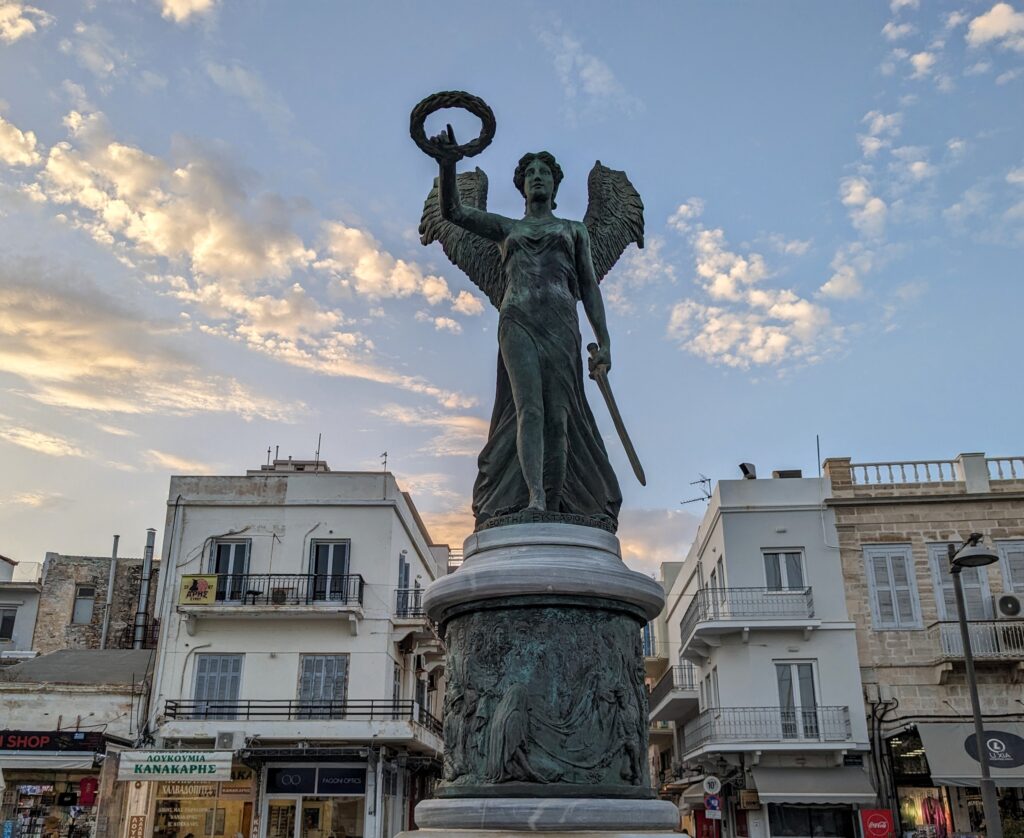
The National Resistance Monument “depicts a grandiose statue of Nike holding a wreath of victory and a large sword! It symbolizes the fight of the Greeks against their conquerors during the Second World War.”
We found an open air restaurant along the waterfront not far from the statue to enjoy the slightly cooler breeze while we had our last dinner in Syros. From our rooftop terrace we watched the luxury yachts come and go.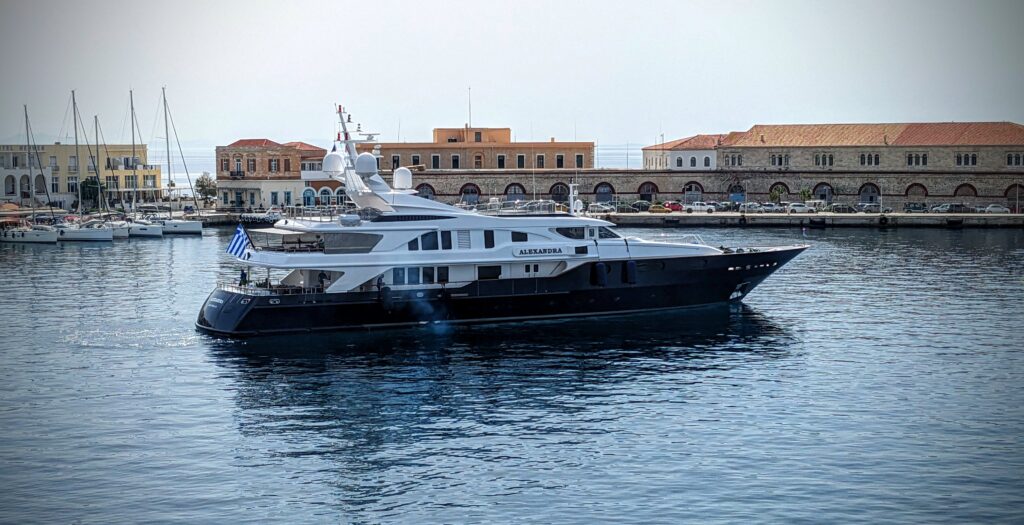 The Alexandra Yacht left at about 10am this morning. Replaced by the O’Pari Yacht, at about 10pm! Too big to get in one photo!
The Alexandra Yacht left at about 10am this morning. Replaced by the O’Pari Yacht, at about 10pm! Too big to get in one photo!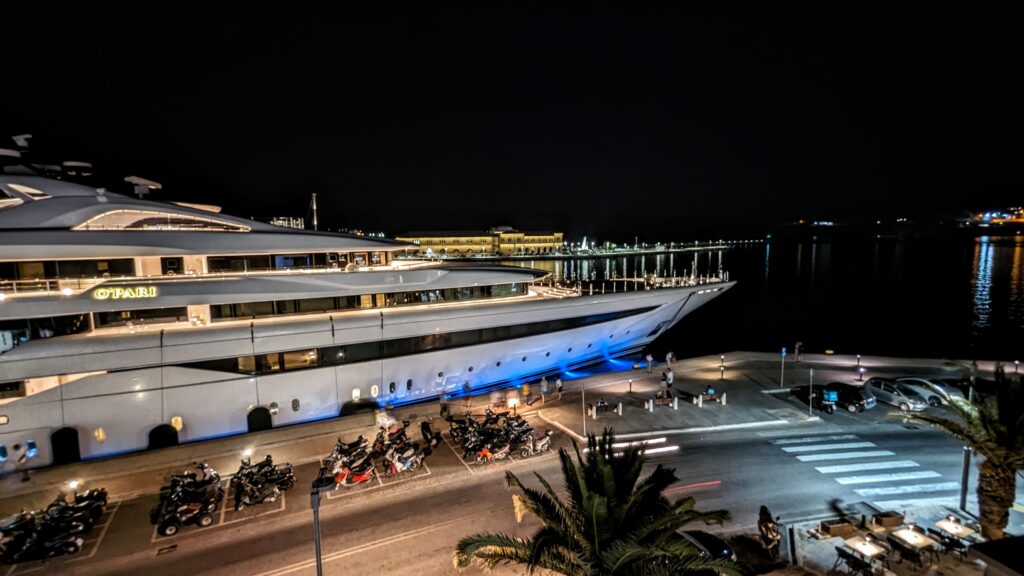
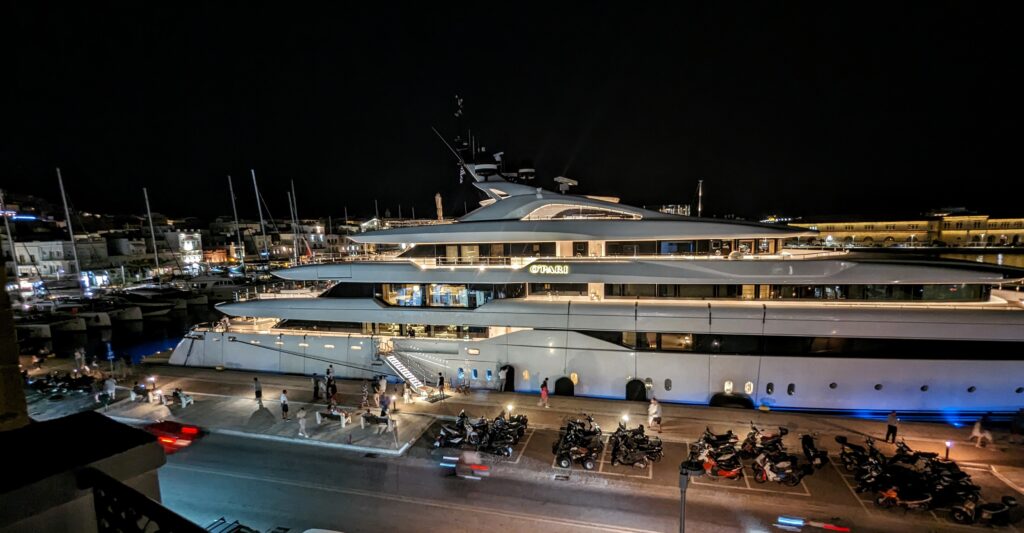 That was some interesting people watching!
That was some interesting people watching!















 First off she explained the propensity of headless, armless statues! Wear and tear of course, the neck and arms being weak points in sculpture, easily fractured, and the fact that they made the statues en masse, to be interchangeable! The heads were sculpted separately to match the subject, and the arms could be holding different objects; law books, scrolls, wreathes, etc.!
First off she explained the propensity of headless, armless statues! Wear and tear of course, the neck and arms being weak points in sculpture, easily fractured, and the fact that they made the statues en masse, to be interchangeable! The heads were sculpted separately to match the subject, and the arms could be holding different objects; law books, scrolls, wreathes, etc.! Another statue showing the insert for the appropriate head!
Another statue showing the insert for the appropriate head!



















 The
The 
 That was some interesting people watching!
That was some interesting people watching!